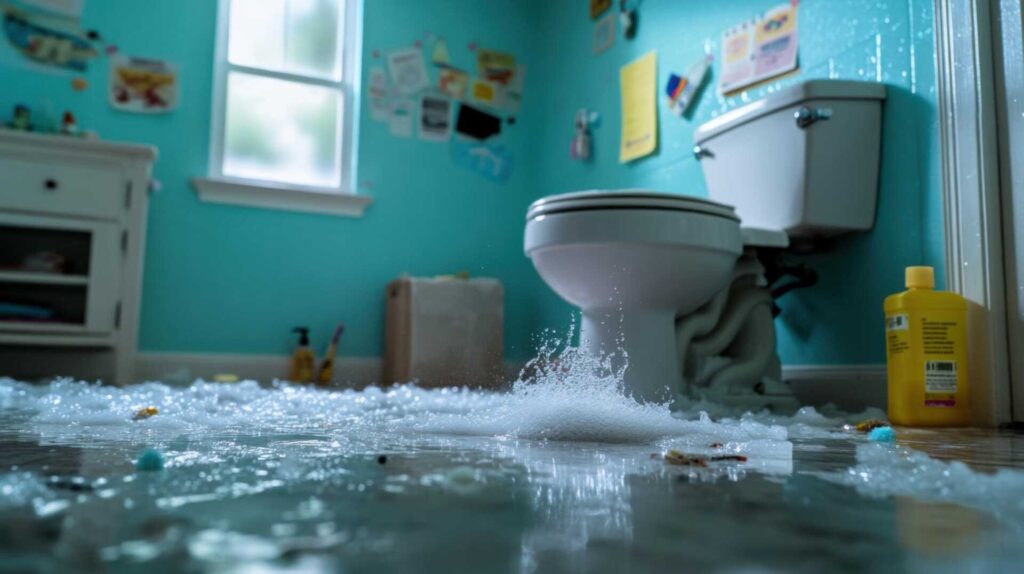
Contents
When you’re faced with a sewage cleanup situation, knowing the right techniques can make all the difference. You’ll want to start with a thorough assessment of the contamination, ensuring you identify all potential hazards. From there, implementing rigorous safety precautions is essential to protect yourself and others. But that’s just the beginning; the tools and methods you choose for water extraction and disinfection can greatly impact the effectiveness of the cleanup. Curious about the specific strategies and equipment that can streamline this process? Let’s explore those next.
Key Takeaways
- Conduct thorough assessments to identify contamination sources and evaluate risks before initiating cleanup efforts.
- Utilize high-capacity pumping systems for efficient removal of sewage and standing water, ensuring proper equipment setup.
- Implement strict safety protocols, including personal protective equipment and decontamination procedures, to protect cleanup personnel.
- Apply EPA-approved disinfectants and odor neutralizers to eliminate pathogens and manage foul smells effectively.
- Follow proper waste management practices, including segregation and compliance with local disposal regulations, to minimize environmental impact.
Assessment of Contamination
When evaluating contamination following a sewage spill, you must first identify the extent and type of pollutants present.
Begin by investigating the contamination sources, which can include raw sewage, industrial waste, or agricultural runoff. Understanding these sources helps you assess potential risks to both human health and the environment.
Next, conduct a thorough risk evaluation. This involves sampling the affected area to analyze the concentration of contaminants. Use appropriate testing methods to determine the presence of pathogens, heavy metals, or harmful chemicals.
Document your findings meticulously, as they’ll guide the cleanup strategy and inform the community about potential hazards.
It’s essential to engage with local stakeholders during this process. Communicate openly about what you discover, and encourage their input. This fosters a sense of belonging and collaborative effort in addressing the contamination.
Keep in mind that the nature of the pollutants can vary greatly, affecting the urgency and methods of remediation.
For instance, biological contaminants may require different handling techniques compared to chemical pollutants.
Safety Precautions
Following the assessment of contamination, establishing safety precautions is vital for all personnel involved in the cleanup process. You must prioritize your health and safety by understanding the potential health risks associated with sewage exposure. This environment harbors bacteria, viruses, and chemical hazards, which can lead to serious health issues.
Before you begin, make certain you have the appropriate protective gear. This includes waterproof gloves, goggles, and masks to prevent inhalation of harmful particles. Wearing long-sleeved clothing and rubber boots can help shield your skin from contaminants.
Always remember that your safety is a collective responsibility; encourage your team to adhere to these guidelines.
It’s essential to establish a decontamination area where you can safely remove and dispose of contaminated clothing and gear. This area should be separated from the cleanup zone to minimize the risk of cross-contamination. Make sure to wash your hands thoroughly after removing protective gear, even if you wore gloves.
Regularly communicate with your team about the importance of these precautions. Conduct briefings to make certain everyone understands the potential health risks and the necessary steps to mitigate them.
Establishing a culture of safety fosters teamwork and helps everyone feel valued within the group.
Equipment and Tools
Proper equipment and tools are critical for effective sewage cleanup. Using the right gear enhances your efficiency and ensures safety throughout the process.
Here’s a quick breakdown of key equipment you’ll need:
Pumping Systems: These are essential for removing sewage quickly and efficiently. Choose a high-capacity pump designed to handle solid waste, ensuring that you can evacuate contaminated water without delay.
Containment Barriers: To prevent the spread of sewage and protect unaffected areas, utilize containment barriers. These physical barriers help you isolate the contaminated zone, allowing for a more controlled cleanup process.
Personal Protective Equipment (PPE): You’ll need gloves, masks, and protective clothing to minimize health risks. Verify your PPE meets safety standards and is suitable for the hazards associated with sewage exposure.
When tackling sewage cleanup, remember that using inadequate tools can lead to prolonged exposure and potential health risks.
Always check your equipment before starting to verify it’s functioning correctly. If you’re part of a team, communication is key—make sure everyone knows how to use the tools effectively and understands the importance of safety protocols.
Taking these steps protects you and fosters a sense of responsibility and belonging within your team. By being well-prepared, you contribute to a safer and more efficient sewage cleanup process.
Water Extraction Methods
After ensuring you have the right equipment and tools, the next step in sewage cleanup involves effective water extraction methods.
You’ll want to prioritize using robust pumping systems to remove standing water quickly and efficiently. These systems are designed to handle contaminated water, ensuring your space is returned to a safe condition as soon as possible.
Begin by setting up your pumping system, ensuring it’s connected correctly and positioned at the lowest point of the affected area. This allows for ideal water removal. Monitor the process closely, adjusting the system as necessary to maintain efficiency.
As the water level decreases, you’ll need to switch to absorption materials to soak up any remaining moisture.
Absorption materials, such as specialized pads or towels, play a vital role in ensuring no excess water is left behind. They’re particularly effective in areas that are hard to reach with pumping systems, like corners or under furniture. Be diligent in replacing these materials frequently to maximize their effectiveness.
Safety is paramount during this process. Always wear protective gear, including gloves and masks, to shield yourself from contaminants.
After water extraction, thoroughly clean and disinfect the area to prevent mold growth and further health risks.
Sewage Cleanup Techniques
Sewage cleanup techniques are vital for restoring safety and hygiene in contaminated areas. When dealing with sewage spills, it’s important to follow a structured cleanup protocol to mitigate biological hazards effectively.
Here’s a step-by-step approach to ensure a thorough and safe cleanup:
Personal Protection: Before starting the cleanup, equip yourself with appropriate personal protective equipment (PPE), including gloves, masks, and rubber boots. This gear helps shield you from harmful pathogens found in sewage.
Containment and Removal: Block off the affected area to prevent unauthorized access. Use pumps and wet vacuums to remove standing water and sewage. This step is significant as it helps minimize the risk of spreading contaminants.
Sanitization and Disposal: Once the area is cleared, thoroughly sanitize all surfaces using industrial-grade disinfectants. Pay special attention to porous materials, as they can harbor biological hazards. Dispose of all contaminated materials in compliance with local regulations.
Following these techniques ensures a safer environment and fosters a sense of community responsibility.
By adhering to these protocols, you contribute to the well-being of your neighborhood, supporting a collective effort to maintain hygiene and safety standards.
Disinfection and Deodorization
How can you ensure that contaminated areas become safe and free from unpleasant odors? First, you need to employ effective disinfection methods that target harmful pathogens present in sewage.
Using EPA-approved disinfectants is essential; these products can eliminate bacteria, viruses, and fungi. Make certain to follow the manufacturer’s guidelines for application, making sure the solution remains in contact with surfaces for the recommended dwell time. This step is critical for achieving maximum efficacy.
Once disinfection is complete, focus on deodorization techniques to remove lingering odors. You might consider using odor neutralizers that chemically bind with odor-causing molecules, rendering them ineffective.
Products containing activated charcoal or zeolites are particularly effective, as they absorb and trap odors effectively. Another option involves using enzymatic cleaners, which break down organic matter responsible for foul smells, leaving a fresher environment.
Additionally, it ensures proper ventilation in the area during this process. Natural airflow can help disperse odors and promote the effectiveness of your deodorization techniques.
If odors persist, consider using fogging machines that disperse deodorizing agents throughout the affected space, ensuring thorough coverage.
Waste Disposal Procedures
When dealing with sewage cleanup, proper waste disposal procedures are fundamental for ensuring safety and environmental protection. Effective waste management is essential in minimizing health risks and protecting the ecosystem.
Here’s how you should handle waste disposal:
Segregate Contaminated Waste: Start by identifying and separating hazardous materials from other waste. Use clearly labeled bags for different types of waste, such as solid waste, liquids, and personal protective equipment (PPE). This step is important for efficient disposal methods later on.
Use Approved Disposal Methods: Once you’ve segregated the waste, utilize disposal methods that comply with local regulations. This could involve transporting solid waste to a licensed landfill or using specialized services for hazardous waste. Always consult local environmental agencies for guidelines to ensure compliance.
Document Waste Disposal: Keep detailed records of the waste generated and the disposal methods used. This documentation helps in regulatory compliance and serves as a reference for future cleanup operations.
Review
In sewage cleanup, efficiency and safety are paramount. By following a systematic approach that includes thorough assessments, rigorous safety precautions, and the right equipment, you can greatly reduce these risks. Remember, effective disinfection and proper waste disposal are essential to protect both the environment and your community. Stay informed and prepared to tackle any sewage contamination effectively.
Recent Posts
Mastering Biohazard Sewage Cleanup Techniques
Is it really worth the risk to tackle biohazard sewage cleanup without the right techniques?
Top Leak Detection Services for Homeowners
Is it true that most homeowners underestimate the impact of undetected leaks? You might think
What Are Effective Sewage Cleanup Solutions?
You might not realize that improper sewage cleanup can lead to long-term health risks and

